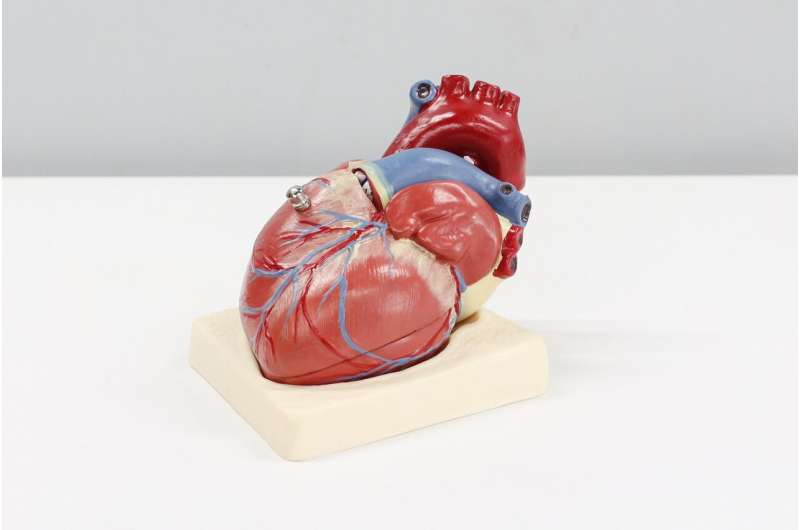This article has been reviewed according to Science X's editorial process and policies. Editors have highlighted the following attributes while ensuring the content's credibility:
fact-checked
peer-reviewed publication
proofread
Study confirms efficacy of ezetimibe combination therapy for LDL-C reduction in high risk patients

Moderate-intensity statin with ezetimibe combination therapy was confirmed to be effective on low-density lipoprotein cholesterol (LDL-C) reduction in patients at very high risk of atherosclerotic cardiovascular disease. The research team found out that the therapy has a higher compliance rate for continuous medication administration than the conventional high-intensity statin monotherapy.
The research, "Moderate-Intensity Statin With Ezetimibe Combination Therapy vs. High-Intensity Statin Monotherapy in Patients at Very High Risk of Atherosclerotic Cardiovascular Disease: A Post Hoc Analysis From the RACING Randomized Clinical Trial," was published in JAMA Cardiology.
In order to prevent the recurrence of myocardial infarction or stroke and psychogenic death, it is crucial to maintain LDL-C levels lower than 55mg/dL or 70mg/dL for patients at a very high risk of atherosclerotic cardiovascular disease. Statin drug therapy is the most often used method as it inhibits LDL-C synthesis in the liver.
However, continued treatment with high-dose statin may cause a high risk of side effects such as muscle damage, decreased liver function, and increased blood sugar levels. This is why the long-term administration of high-dose statin was difficult and the safety of treatment an important task.
In particular, Korea has become a super-aging society. Due to the expansion of westernized diets, the number of patients suffering from serious diseases such as myocardial infarction and cerebral infarction is increasing. This resulted in the increase of more people at high risk of atherosclerotic cardiovascular disease, which is more likely to develop in severe vascular occlusive disease due to underlying diseases and arteriosclerosis throughout the entire body. The necessity of this treatment has become more important than ever.
The research team analyzed and compared the treatment effects of moderate-intensity statin with ezetimibe combination therapy and high-intensity statin monotherapy in 1,511 patients at very high risk of atherosclerotic cardiovascular disease.
Patients at very high risk of atherosclerotic cardiovascular disease are defined as patients with 12 diseases, including a history of myocardial infarction, peripheral artery disease, and high blood pressure. The patients were randomized into two treatment arms and followed for three years to analyze the average LDL-C level, the complication incidence such as heart failure, myocardial infarction, and cerebral infarction, as well as the patient's compliance to continuous medication administration.
As a result, the analysis of LDL-C on both treatment arms during the observation period showed 57mg/dL for the combination therapy arm and 65mg/dL for the monotherapy arm. The former represented a greater reduction of LDL-C. The complication incidence such as heart failure, myocardial infarction, and cerebral infarction for the combination therapy arm was at 11.2% which had no significant difference from the monotherapy arm (11.7%).
A more important aspect was intolerance to medication. The rate of discontinuation for the combination therapy arm was 4.6%, which was lower than 7.7% for the monotherapy arm. This proved the former is more advantageous in terms of continuous medication dose.
The research team was led by Professor Soon Jun Hong and Jung-Joon Cha of the Department of Cardiology, Cardiovascular Center, Korea University's Anam Hospital, and Professor Jung-Sun Kim and Seung-Jun Lee of the Division of Cardiology, Severance Hospital, Yonsei University College of Medicine
Professor Soon Jun Hong explained that "patients at very high risk of atherosclerotic cardiovascular disease must reduce their LDL-C level. They require not only the effectiveness of the drug but also compliance to the treatment, that is, the stability of being able to receive continuous treatment without interruption. This study confirmed the safety of combination therapy, so we expect more patients would get help from this therapy on reducing LDL-C."
Professor Jung-Joon Cha said, "Patients at very high risk of atherosclerotic cardiovascular disease had to discontinue their treatment often due to complications. Now, medical specialists can prescribe more treatment attempts using the combination therapy. This study was for patients at very high risk of atherosclerotic cardiovascular disease, but we will continue our research to make sure more patients would get better treatments and expand diseases for which medication is efficacious."
More information: Seung-Jun Lee et al, Moderate-Intensity Statin With Ezetimibe Combination Therapy vs High-Intensity Statin Monotherapy in Patients at Very High Risk of Atherosclerotic Cardiovascular Disease, JAMA Cardiology (2023). DOI: 10.1001/jamacardio.2023.2222




















